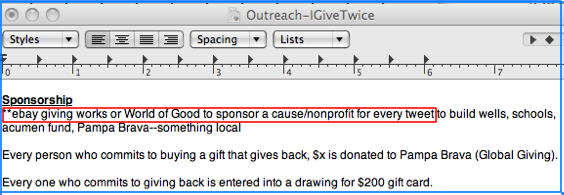
For less than $300 dollars and in under two weeks I launched an awareness campaign, powered through Twitter, to encourage people to choose gifts that have a social or environmental benefit. This is story of what what worked, what didn’t and why I set up virtual shop at iGiveTwice.com.
Near the end of November I saw a tweet from my friend Noland Hoshino about his commitment to buy only holiday gifts that gave back. His commitment stuck with me because I believe that if enough consumers commit to this, we can affect real change through our purchases. Americans spent $460 billion on holiday shopping in 2008–that’s a big budget for change. It’s also easier to make this commitment than it was even two years ago with the surge of cause-worthy products now on the market. Buying responsibly no longer means a sacrifice in quality, selection or price. So I decided to join Noland in his pledge, but I also wanted to encourage others to do the same.
I had a limited time to build something (Black Friday was a week away) and limited funds. I ruled out developing a product directory (some already exist, they are time-consuming, ephemeral and don’t leverage what I’m good at). Instead, I would create an awareness campaign that would plug into Twitter (arguably, the biggest social media engine out there) and show people that doing good is easy if you take one moment to choose a product with a social benefit. So here’s what I did.
The Work
- Drafted a mission statement and key requisites (functioning, action-generating, clear).
- Outlined the basics of the site in a Word doc (Andrew Warner helped me conceptualize this and keep it simple).
- Jotted down an outreach plan listing individuals whom I could ask for feedback, support and tweets, as well as media outlets that would be interested in the campaign.
- Submitted a project proposal to Elance.com with timeline, budget and parameters.
- I also laid out a fantasy plan to partner with WorldofGood.com, the most comprehensive marketplace for responsible products, to raise money for a non-profit beneficiary.

What I learned from THE PARTS THAT WORKED
- I now know it’s possible to have a functioning and relatively well-designed site built for $285 (including bonuses) in two weeks.
- I learned to launch something imperfect. I struggled with this a lot. Nothing was quite as I wanted it but I was reminded of my broader mission: to get consumers to understand that with a small effort, they can affect change.
- It’s okay to ask for help, if not always comfortable. I asked many people for their help in submitting a product, tweeting about it–even writing about it. There are some people who are very good at asking for help. When they ask me, I feel happy to be included and able to help them. I’m working to develop this skill.
- The sponsors are there if I step up and ask. Via Twitter, I approached WorldofGood.com about a partnership with iGiveTwice. After a couple of phone calls, emails and a leap of faith on their part, eBay’s WorldofGood.com and Giving Works agreed to partner with iGiveTwice and to donate $1 to Heifer International, up to $2,500, for every tweet that mentioned either organization and iGiveTwice. As I mentioned in #5 above, this was exactly my dream partnership for iGiveTwice. Not only is the partnership logical, but I have tremendous respect for WorldofGood.com by eBay, Giving Works and Green Team’s efforts to promote sustainability and social progress.
- iGiveTwice can be a means to drive qualified traffic. WorldofGood.com experienced its best traffic from Twitter to the site to date.
What I learned from THE PARTS THAT DIDN’T WORK
- What follows is the hard part to write, but I know the value of transparency: the partnership with eBay raised only $150 dollars for Heifer International, which will be used to buy a goat and honeybees. The tweets that triggered the donation accounted for one-sixth of overall #iGiveTwice tweets. With input from my contact at WorldofGood.com, here’s why we feel it didn’t work so well:
- The tweets were confusing (Tweet the link to your fav gift on eBayGiving Works, include @eBayGiving & #igivetwice tag & $1 goes to @Heifer Please RT.) Only one message should accompany the hashtag, which gives the “directions” and the campaign message. We asked users to a) link to a product from WorldofGood.com or GivingWorks.ebay.com; b) tag it #igivetwice and @WorldofGood_com or @ebayGiving; c) tweet it; and d) ask for retweets.
- There were too many names involved: iGiveTwice (unfamiliar to users), WorldofGood.com, Giving Works, Heifer International and product names.
- Short lead time. iGiveTwice.com went live December 5, after most holiday articles were published and most consumers had finished their online shopping.
- Asking people to tweet links from a specific site undermined the campaign’s impartiality.
- Involving more partners means there are more needs to satisfy. With so many suggestions and objectives, it’s best to keep it simple and to continually refer back to the original mission.
- Lost Twitter data. I used Twitter to store #iGiveTwice tweets and the products that users tweeted about. Unfortunately, these tweets have been “Temporarily Unavailable” for several weeks. I don’t have a final count of the campaign tweets or how many products and companies were tweeted about and linked to via the campaign.
- iGiveTwice.com’s message and action steps were unclear. There was a significant disconnect in encouraging people to choose gifts that give back and not presenting them with an immediate marketplace to buy these gifts.
For Next Time
One of the best aspects of a social media campaign is the communication that it inspires among your target audience and the partners you work with. I was incredibly fortunate to work with sharp minds and generous hearts from WorldofGood.com and Heifer International. These takeaways represent our collective thoughts on how the campaign could be improved.
- I will have a clearer message and action steps for users. Ex: “For every click on X link, $1 is donated.” This is easy to understand, retweet and track through a bit.ly link;
- Plan for greater lead time to get influencers and the media involved first;
- Gather an informal panel of advisors to provide feedback, structure and publicity; and
- Invite another sponsor to serve as a “match donor,” which would help raise more money with less effort. I will need to balance this additional partner with the clarity of tweets and adherence to my original mission.
I’d love to hear from you. If you caught the campaign, what else could I have done to improve it? Have you faced any of these issues and how have you dealt with them?





 I'm Olivia Khalili. I created Cause Capitalism to show you how to grow your business by incorporating a social mission.
I'm Olivia Khalili. I created Cause Capitalism to show you how to grow your business by incorporating a social mission. 

Hi Olivia,
Nice to see you here as well as on Twitter!
I loved what you did. I would strongly encourage you to do this again next year. Your network will be larger and stronger and you will have the benefit of this year’s mistakes and successes.
I applaud your work. Any dollar raised is a dollar they would not have received without your efforts, so way to go!!!
See you with all the Twitter buds!
Heidi
Heidi thanks for your support. I agree that my next campaign/project will benefit from this past year’s and from the advice and support of people like you. Thanks again.
Even if this wasn’t as successful as you had hoped, it was a great first start. As the saying goes, each time you fail, fail better than you did the last time. I think the hardest part of starting something is always taking the first leap. Kudos for jumping in headfirst!
Two things:
(1) I agree that the tweets were a bit confusing. I remember not understanding exactly what to do.
(2) I agree that more lead time would be helpful. People like to donate to things that have momentum. My suggestion for next time is round up some donors ahead of time behind the scenes so that when you are ready to launch the campaign you can tweet shortly thereafter about how you’ve already raised X amount of money. People like to follow the leader and if others are already tweeting/donating, they’ll tweet/donate too.
Lastly, December, may not be the best month for the campaign. Traditionally, December has been known as a good time for giving as people make end-of-year donation to their pet charities at this time of year for tax purposes.
However, at GiveForward this is actually one of our slowest times of the year. People are on their computers less around the holidays and they are busy thinking about holiday meals and presents. Our web traffic and donations go down drastically in Dec and don’t generally pick up until after the new year.
Hope this helps for your planning!
Ethan,
Great suggestions about recruiting advanced donations. The campaign turned mid-way; I hadn’t foreseen it as a fundraising tool but simply as a tool to raise awareness for ethical products and to loosely drive traffic to responsible producers and merchants.
Interesting that you see a drop in giving/contributions in December. Thanks again for your thoughts.
Another point I want to add is the difficulty of measuring the ‘success’ of the campaign. Particularly when I launched it (and it didn’t have a tandem fundraising goal) I had a hard time developing a metric for ‘success.’ Because I wasn’t driving traffic to one merchant or one product, I couldn’t measure traffic and conversion rates. This is something I would spend more time planning for my next go around.
Sorry to be late with my comment, Olivia. Thank you for this wrapup and for your great honesty. Your experience is a terrific case study that should be helpful to others about what to do and not do when executing their great ideas into practice. Congratulations on your work and heart.
Joanne, thanks for this comment and for your support. I felt it was important (and somewhat scary) to share the honest results and take-aways.